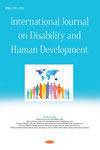A survey of disabled persons about their physical activity
International Journal on Disability and Human Development
Pub Date : 2016-02-01
DOI:10.1515/ijdhd-2014-0014
引用次数: 1
Abstract
Abstract Background: According to a new report by the World Bank and the World Health Organization, persons with disabilities currently constitute 15% of the world’s population, and most of these persons live in rural areas in developing countries. Many of these persons lack equal access to health care, education, job opportunities and other necessary services. One of the challenges to independence and use of public spaces is a lack of attention to physical activity and mobility needs. Methods: To evaluate the association between physical activity and chronic disease and function outcome, 82 subjects with physical disabilities were given the Physical Activity questionnaire for Individuals with Physical Disabilities (PASIPD). The PASIPD consists of 13 items: six leisure time activities, six household activities and one Work-related activity. Leisure activities include walking and wheeling outside the home other than specifically for exercise as well as light, moderate and strenuous sport and recreation exercise to increase muscle strength and endurance. Household activities include light and heavy housework, home repair, lawn work, outdoor garden, caregiving for another person and occupational activity other than office work. Results: In general, PASIPD scores differed significantly and in the expected direction between groups differing by age and levels of self-rated health and self-rated physical activity. Differences also existed in PASIPD total or subcategory scores by gender, type of disability and presence or absence of attendant care. Conclusions: A sufficiently physically active lifestyle would be beneficial for individuals with physical disabilities, who are on average more sedentary than the general population. There is a need for a reliable and valid measure of physical activity for research in this specific population, and this scale is useful for evaluating associations between physical activity and chronic disease and functional outcomes.对残疾人身体活动情况的调查
背景:根据世界银行和世界卫生组织的一份新报告,残疾人目前占世界人口的15%,其中大多数生活在发展中国家的农村地区。其中许多人缺乏平等获得保健、教育、就业机会和其他必要服务的机会。公共空间的独立性和使用面临的挑战之一是缺乏对身体活动和流动性需求的关注。方法:为评估体力活动与慢性疾病和功能预后的关系,对82例体力活动障碍患者进行体力活动问卷调查。PASIPD包括13个项目:6个休闲活动,6个家庭活动和1个工作相关活动。休闲活动包括在户外散步和骑车,而不是专门用于锻炼,以及轻度、中度和剧烈的运动和娱乐运动,以增加肌肉力量和耐力。家庭活动包括轻家务和重家务、房屋修理、草坪工作、户外花园、照顾他人以及办公室工作以外的职业活动。结果:总体而言,PASIPD得分在年龄、自评健康水平和自评身体活动水平不同的组之间存在显著差异,且在预期的方向上存在差异。PASIPD总分或亚类得分也存在性别、残疾类型和有无护理的差异。结论:充分锻炼身体的生活方式对身体残疾的人是有益的,他们平均比一般人更久坐。在这一特定人群的研究中,需要一种可靠和有效的身体活动测量方法,这种量表对于评估身体活动与慢性疾病和功能结果之间的关系是有用的。
本文章由计算机程序翻译,如有差异,请以英文原文为准。
求助全文
约1分钟内获得全文
求助全文

 求助内容:
求助内容: 应助结果提醒方式:
应助结果提醒方式:


